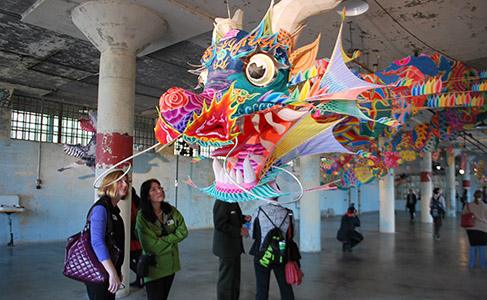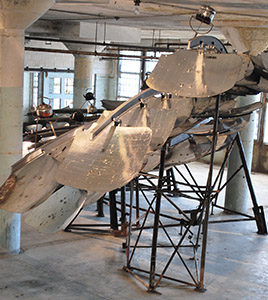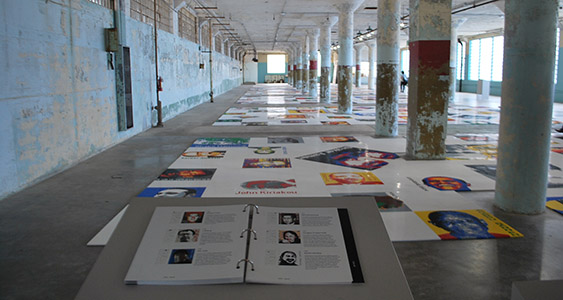A new art exhibit opened on Alcatraz Island last month featuring works by Ai Weiwei, a Beijing-based artist and activist whose work encompasses sculpture, installation, photography, film, architecture and social criticism.

One of the more spectacular installments in the @Large: Ai Weiwei on Alcatraz exhibit is With Wind, a large scale contemporary version of the traditional Chinese dragon kite. Photo by Joel Williams
BC Staff Report
Published: October, 2014
A new art exhibit opened on Alcatraz Island last month featuring works by Ai Weiwei, a Beijing-based artist and activist whose work encompasses sculpture, installation, photography, film, architecture and social criticism. Featuring seven new sculpture, sound and mixed-media works, @Large: Ai Weiwei on Alcatraz explores human rights and freedom of expression in the context of this iconic historic site.
Inspired by the island’s layered history as a 19th-century military fortress, notorious federal penitentiary and significant site of Native American history, the exhibition is installed across four locations on Alcatraz and will be on view through April 26, 2015.
The intention of Ai’s artworks in @Large is to raise urgent questions about the social implications of incarceration and the definitions of liberty, justice, individual rights and personal responsibility as interpreted through the lens of the artist’s personal experiences. For Ai, the inspiration for the exhibition is not simply an exploration of social issues or artistic themes; it is rooted in the reality of his life. In spring 2011, Ai was detained by the Chinese government for 81 days on charges of tax evasion. Following his release, he was prohibited from leaving Beijing for one year, and he is still forbidden to travel outside of China. Because Ai could not visit Alcatraz, he developed the works in his Beijing studio with support from the presenting partners, Bay Area volunteers and Amnesty International, which provided research material.
“One of the qualities that first struck me about Ai’s practice is how profoundly he explores the confluence of art and the built environment and how aware he is of the impact his work has on the viewer—making our collaboration with him ideal for a project focused on exploring place, history and the human condition,” said Cheryl Haines, founding executive director of the FOR-SITE Foundation and curator of @Large. “The balance of content and materiality that exists in his works at once awes us with its grace and beauty and challenges and critiques our ways of thinking—in a manner that we hope will catalyze a critical public dialogue about human rights and the many other issues that Ai explores through his art and activism.”
Three of the site-specific installations are located in the two-story New Industries Building where “privileged” inmates were permitted to work:
With Wind
This large-scale installation, located in the building once used for prison labor, features a contemporary version of the traditional Chinese “dragon kite,” a large multipart kite handmade by Chinese artisans in collaboration with Ai’s studio. Scattered around the room are other kites decorated with stylized birds and flowers, which speak to the natural environs of Alcatraz Island—an important bird habitat—and reference 30 nations with serious records of restricting their citizens’ human rights and civil liberties. The position of the kites—trapped inside a building, unable to fly—suggests the powerful contradiction of freedom and restriction.
Trace
In this installation, the viewer is confronted with a field of more than 175 colorful portraits laid out across an expanse of the floor. Each portrait—intricately constructed from Lego bricks—represents an individual who has been imprisoned or exiled because of his or her beliefs, actions or affiliations. Fabricated by hand in the artist’s Beijing studio and by a team of volunteers in San Francisco, the installation, consisting of over a million individual pieces, gives a human face to political detainment.
Refraction
Using the imagery of flight to evoke the tension between freedom and confinement, this monumental installation—weighing more than five tons—is modeled after a bird’s wing. The artwork consists of reflective panels originally used on Tibetan solar cookers. Located on the lower floor and viewed from the gun gallery above, the installation positions the visitor in the role of the prison guard, implicating the viewer in a complex structure of power and control.
The other four works are located in the hospital main ward and psychiatric observation cells; A Block, the only cellblock not remodeled since the military prison was constructed in the early 20th century; and the dining hall:
Stay Tuned
Located in A Block, Stay Tuned features an intimate and evocative sound installation in 12 individual cells where visitors can sit and listen to spoken words, poetry and music by people who have been imprisoned for the creative expression of their beliefs. Each cell features a different recording, such as works by the Russian punk band Pussy Riot and the South African anti-apartheid activists Robben Island Singers.
Illumination
Located in the hospital’s psychiatric observation cells, the tiled cells resonate with chanting recorded at a Buddhist monastery and a traditional song of the Hopi tribe. Men from the Hopi tribe were among the first prisoners of conscience held on Alcatraz.
Blossom
Also located within the hospital, intricately detailed encrustations of ceramic flowers transform utilitarian fixtures (sinks, toilets and tubs) into fantastical, fragile porcelain bouquets.
Yours Truly
Located in the Dining Hall, this interactive work encourages visitors to write postcards addressed to some of the prisoners represented in Trace. Ai has spoken of the deep feeling of isolation that afflicts incarcerated people and the fear that their causes have been forgotten. Yours Truly is a direct response to these concerns—serving as a reminder that their voices and causes have not been forgotten, and as a springboard for visitors to engage in a global conversation about the responsibilities that we all bear as members of the international community.
With the exception of the Dining Hall, all of the exhibit locations are not usually open to visitors, but all will be open to the public throughout the run of the exhibition. The @Large exhibition is included as part of general Alcatraz admission.
Alcatraz is one of the country’s most popular national park sites, attracting more than 1.4 million people each year. Given Alcatraz’s popularity, admission tickets typically sell out several weeks in advance. With the expected increased demand due to the @Large exhibition, the public is encouraged to purchase tickets as early as possible. Tickets may be purchased up to three months in advance online at www.alcatrazcruises.com.

Refraction was created with reflective panels originally used on Tibetan solar cookers. Photo by Joel Williams

Over a million Lego blocks were used to create a field of more than 175 colorful portraits laid out across an expanse of the floor in the New Industries Building on Alcatraz. Folders are available with details regarding the depicted individuals who have been imprisoned or exiled because of his or her beliefs, actions or affiliations. Photo by Joel Williams

